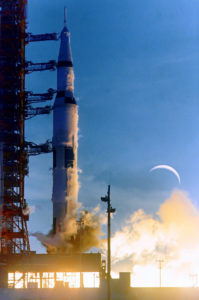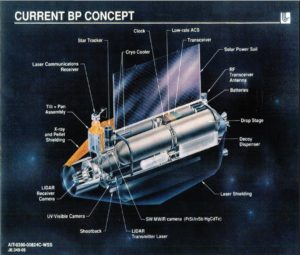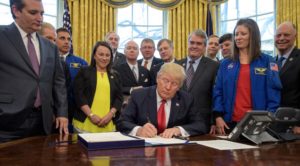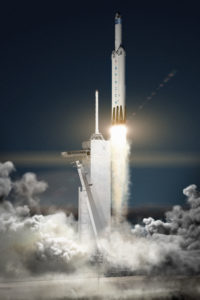
The mighty Saturn V, off to the Moon.
As we approach the anniversary of the first landing on the Moon (48 years on July 20), it is traditional for space opinion writers to wistfully look back on that lost “Golden Age” when humans ventured beyond low Earth orbit and set foot on another world. This lament for the past is particularly acute within NASA, whose entire self-image is wrapped around a romanticized vision of a tough, risk-taking, and technically competent organization. “Failure is not an option!” Just ignore the fact that Gene Kranz never said that, at least while the mission was underway (he did use it much later as a book title). Hollywood writes history these days, not the other way around.
Simultaneously, the Apollo missions to the Moon are the acme of American space achievement and the anchor weighing it down. And it is this paradoxical status that makes the age of Apollo both a blessing and a curse. It was a blessing because it showed us what was possible in space, yet also a curse, for convincing many that the Apollo approach and architecture remains the Holy Grail for great accomplishment in spaceflight. I submit that we must continue to honor and celebrate the glory, but now we must throw off the curse.
Let us briefly recall why America went to the Moon. The effort was not undertaken to develop the means for human spaceflight, or to settle the Solar System, or to explore the wonders of the cosmos. It was done in our bid to achieve a difficult, technical task ahead of the Soviet Union. By 1961, that communist nation had racked up a number of impressive space “firsts,” including the first satellite, the first man in space, and the first probe to the Moon. Hoping to challenge the Soviets on a very public stage and win, the United States considered several different complex technical projects (including President John F. Kennedy’s personal favorite – the desalination of seawater). Space was the chosen playing field. Though the Soviets were ahead in building large rockets and could possibly build an Earth-orbiting space station, neither nation had yet mastered the ability to land a man on the Moon.
Kennedy asked NASA to devise an approach that would give the United States its best chance to beat the USSR to the Moon. Although NASA had many imaginative and competent engineers at that time, its spiritual godfather and guru was Wernher von Braun. In the 1950s, von Braun had devised an elaborate architecture for spaceflight and published it in a series of articles (with contributions from other space experts) in Collier’s, a popular national magazine. This architecture was incremental and cumulative – the development of pieces for a space transportation system that gradually but continuously expanded human reach into space. Those pieces were: Earth-to-orbit rockets, a space station in Earth orbit, a “Moon tug” to travel back and forth between Earth orbit and the Moon, and finally a manned Mars spacecraft. Each piece was optimized to serve its particular function, and to work in tandem with the other pieces – incremental and cumulative, whereby they would collectively permit the movement of people and cargo between Earth, Moon and the planets.
The von Braun template was a no-go, as the gauntlet thrown down by President Kennedy came with a deadline: “before this decade is out.” But building an infrastructure for a permanent, spacefaring system requires time, and in a race, time is not a free variable. Hence, NASA instead developed an architecture that launched everything needed to travel to the Moon and back with a single (or at most, double) launch. This architecture required a mega-heavy lift booster, one capable of hurling over 100 metric tons to LEO. The subsequently developed Saturn-Apollo system was truly an engineering marvel – one that brilliantly completed its assigned task. Some within NASA thought they might continue using this newly developed Apollo-Saturn hardware to explore the Moon and go to Mars. But the Apollo system was handcrafted and thus, cost much more than the nation was willing to spend on space hardware. In a bid to make spaceflight both cheaper and routine, decision makers turned to the development of a reusable Space Shuttle.
For its designers, the Shuttle was considered to be the first piece of the original von Braun architecture: shuttle, station, Moon tug, Mars mission. Hence, the Shuttle program was given the official name “Space Transportation System (STS),” as it was believed that Shuttle would be the first piece of this new, incremental spaceflight system. Though routine flight to and from LEO was achieved, the operation of the Shuttle was more difficult than imagined and the cost of spaceflight remained high. After the Challenger accident in 1987, the STS label was banished. But more than a simple name was lost – the central idea of developing an incremental, cumulative spacefaring system also disappeared.
When the goal of a return to the Moon and a Mars mission was announced by President George H.W. Bush in 1989, NASA responded to that challenge with what was essentially a large-scale version of the von Braun architecture (The 90-Day Study). This effort was ridiculed and derided, especially after its supposed total, end-to-end cost was leaked to the press ($600 billion over 30 years, about $20 billion per year on average). Invariably, the contrast was drawn between the then-existent space program of record – the “incremental” Shuttle-Station effort, which had run into multiple technical, programmatic and financial difficulties, and the “all-up” Apollo program, which had achieved great things quickly in the distant past. More firmly than ever, the sense of having lost our way from the previous “golden age” took hold in the space community and it has never departed.
This vague nostalgia for Apollo is especially true inside the agency, which recognizes that it’s lost the sheen of glory it once possessed – proudly working inside buildings where vestiges of the heroes and hardware of that time are enshrined and heralded. NASA is an agency revered due to the great accomplishment of the Apollo program, but because of the long passage of time, it does not appear to comprehend what it took to achieve that vision. Not only did the Apollo program have a clear goal with a deadline but it also drew on an aerospace technical and industrial infrastructure that no longer exists. Hence, we get absurd pronouncements about a fantasy “Journey to Mars,” a program for which there is no technical approach, no fiscal means, and no political will to undertake. Rather than embracing a workable architecture that focuses on building an incremental system fueled by lunar resources – one that could eventually take us to many destinations in deep space – they fixate on the Apollo template to send people to Mars, a “launch it all from Earth” spacecraft system that (they believe) will re-capture the magic and glory of that distant era. This fixation has taken us nowhere and will continue to take us nowhere.
The “curse” of Apollo is not that we once went to the Moon and now cannot, or even the way that we did it, but rather the notion that, because Apollo is the only deep space approach that has been successful, it remains the best way to access deep space. Despite the fact that the original notion behind the development of Shuttle as the first piece of a “space transportation system” had a lot of merit, we continue to plan for a series of launches that send expendable spacecraft to Mars in attempts to resurrect that Apollo-like paradigm of “design, build, launch, use and discard.” That approach is not a sustainable one as evidenced by the fact that it was not sustained, despite the immense good will generated by and for a strong space program.
In the current NASA human spaceflight program, initial flights are scheduled to occur within the next couple of years. The Orion-SLS stack is yet another version of the Apollo template, a re-imagining of the cancelled Project Constellation – built largely because the Congress was concerned that a national capability (the Space Shuttle) was being discarded and that no non-governmental replacement was evident. These are entirely defensible grounds for developing a new spaceflight system, but now the nation is confronted with a decision: Where shall we go and what shall we do with this new spacecraft? And having paid for its development, are we now willing to pay the costs for its operation?
The core SLS vehicle puts 70 metric tons into LEO and could quickly emplace the cornerstone elements (e.g., transfer nodes and stages, spacecraft, landers) of a cislunar transportation system in space. This would be the best use of the SLS system as it is already optimized for cislunar missions. Moreover, the Orion spacecraft with its multi-week dwell capability will be useful for our initial return to cislunar space. But Orion, with its water landing and semi-disposable architecture, cannot be the means by which we establish a permanent space transportation system. We must transition to a permanent space-based system, one emphasizing assets that allow transfer, refueling and reuse between the various energy levels of cislunar space.
We know that the Apollo template can be made to work because it worked in the past – for a price. And that is the curse of Apollo – it worked, whereas an incremental, cumulative system that could move us into the Solar System has never been constructed and shown to work. The Space Shuttle and International Space Station gave us the first two pieces of the von Braun architecture – now Shuttle is gone and Station has limited life left after completing its first decade in orbit. Fifty years hence will we still be writing about the Apollo era and those early days of accomplishment for the American civil space program? Or will we be writing about new discoveries and technology born from our resolve to set our national space program on a new course of spectacular achievement?





